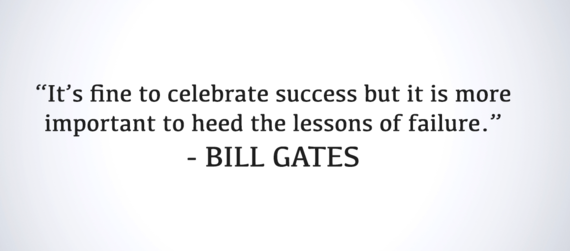Success is not an overnight phenomenon. It requires a unique set of skills built over time. While there is no manual outlining what makes someone successful, the most successful entrepreneurs in the world seem to share these 7 habits.
1. They set goals and outline specifically how to reach them.

Ben Franklin was known for his brilliant inventions and maybe even more so for embodying the modern American entrepreneur. His ability to do so was not a fluke; he planned it.
Research has shown that when an individual sets measurable goals for themselves, they are more like to achieve them. Set specific daily, weekly, monthly, and even yearly goals for yourself and your business. Not only should you write down what your goals are but also determine the optimal path to get you there. In doing this you are able to visualize the path you must take to get there. Consistently review your goals and plans to achieve them on a regular basis.
2. They reflect on their day.

As one of the most powerful women in the world, Oprah Winfrey has shown us that it is possible to do it all. She has conquered television, movies, magazines, and more. What does she credit to her success? The ability to reflect on her day through meditation.
All too often entrepreneurs rush through their day as if it were a sprint, trying to cross off everything on their "to do" list as fast as possible. This can easily lead to a common business-killing phenomenon - burn out. Learn to take time out of your day to reflect. Meditation can come in many forms, all of which are cathartic activities that help you stay grounded and prevent burning yourself out. For some this can be as simple as taking a twenty-minute walk. For others, try writing in a journal.
3. They form mutually beneficial work and personal relationships.

One of the most important things I've learned being an entrepreneur is the ability to culminate relationships with others in your industry that benefit you on both a personal and business level. Ferriss provides us the perfect example of this lesson with how he marketed his book and became friends with others in his industry. When writing his best-seller, "The 4-Hour Work Week", he created chapters he knew certain bloggers would find interesting. This led to an abundance of organic blog mentions, fueling the success of his book and, in the process, helping him create meaningful relationships.
Try to associate yourself with other successful entrepreneurs as much as possible. Doing so will help you learn from them, make you a more capable entrepreneur and possibly lead to more business opportunities.
4. They know how to promote themselves.

Derek Halpern, of the popular psychology/marketing blog SocialTriggers.com, reveals one of the key obstacles holding back most entrepreneurs - they don't know how to promote themselves. There is a fine line between arrogant bragging and (what I like to call) humbly promoting yourself. In order to show people your success without coming off as a pompous jerk, you must master the art of self-promoting.
"Context is everything," says Halpern. Rather than bringing up your accomplishments first, wait for the perfect opportunity, when someone else raises the topic first or provoke them to do so. This makes boasting of your success seem more organic and natural to the conversation you are having.
5. They work for more than money.

Steve Jobs, who has become a legend among entrepreneurs, attributes his success not to chasing money but to the desire to change the world for the better. In doing, so he created some of the world's most brilliant products.
Entrepreneurs that allow their focus to be 100% on financial gain neglect long-term well-being which leads many business owners to feel unfulfilled and depressed. Just as you should have a diversified portfolio of assets, you should diversify your well-being (i.e. spiritual, mental, emotional) in regards to your business.
6. They start before they feel ready.

What holds back many people from even starting their own business is the preconceived notion that they need more experience. The truth in that matter is that there is no "right" time to venture into the world of entrepreneurship. In fact, many (if not all) new entrepreneurs have no idea what they are doing - even the world's most successful such as Richard Branson. Starting a business is like reading a Choose Your Own Adventure book. There are various different ways to reach the end...just be willing to finish the book.
7. They learn from their failures.

Resilience and being able to reflect on your failures is what separates good entrepreneurs from the great ones. The ability to get knocked down over and over while maintaining focus on your end-goal requires tremendous mental fortitude. We often see the most successful business owners invite failure into their lives. A common mantra in the tech world is, "fail fast, fail often". In doing so you spend less time actually failing and more time learning about what got you there so you don't repeat your mistakes.
1. They set goals and outline specifically how to reach them.

Ben Franklin was known for his brilliant inventions and maybe even more so for embodying the modern American entrepreneur. His ability to do so was not a fluke; he planned it.
Research has shown that when an individual sets measurable goals for themselves, they are more like to achieve them. Set specific daily, weekly, monthly, and even yearly goals for yourself and your business. Not only should you write down what your goals are but also determine the optimal path to get you there. In doing this you are able to visualize the path you must take to get there. Consistently review your goals and plans to achieve them on a regular basis.
2. They reflect on their day.

As one of the most powerful women in the world, Oprah Winfrey has shown us that it is possible to do it all. She has conquered television, movies, magazines, and more. What does she credit to her success? The ability to reflect on her day through meditation.
All too often entrepreneurs rush through their day as if it were a sprint, trying to cross off everything on their "to do" list as fast as possible. This can easily lead to a common business-killing phenomenon - burn out. Learn to take time out of your day to reflect. Meditation can come in many forms, all of which are cathartic activities that help you stay grounded and prevent burning yourself out. For some this can be as simple as taking a twenty-minute walk. For others, try writing in a journal.
3. They form mutually beneficial work and personal relationships.

One of the most important things I've learned being an entrepreneur is the ability to culminate relationships with others in your industry that benefit you on both a personal and business level. Ferriss provides us the perfect example of this lesson with how he marketed his book and became friends with others in his industry. When writing his best-seller, "The 4-Hour Work Week", he created chapters he knew certain bloggers would find interesting. This led to an abundance of organic blog mentions, fueling the success of his book and, in the process, helping him create meaningful relationships.
Try to associate yourself with other successful entrepreneurs as much as possible. Doing so will help you learn from them, make you a more capable entrepreneur and possibly lead to more business opportunities.
4. They know how to promote themselves.

Derek Halpern, of the popular psychology/marketing blog SocialTriggers.com, reveals one of the key obstacles holding back most entrepreneurs - they don't know how to promote themselves. There is a fine line between arrogant bragging and (what I like to call) humbly promoting yourself. In order to show people your success without coming off as a pompous jerk, you must master the art of self-promoting.
"Context is everything," says Halpern. Rather than bringing up your accomplishments first, wait for the perfect opportunity, when someone else raises the topic first or provoke them to do so. This makes boasting of your success seem more organic and natural to the conversation you are having.
5. They work for more than money.

Steve Jobs, who has become a legend among entrepreneurs, attributes his success not to chasing money but to the desire to change the world for the better. In doing, so he created some of the world's most brilliant products.
Entrepreneurs that allow their focus to be 100% on financial gain neglect long-term well-being which leads many business owners to feel unfulfilled and depressed. Just as you should have a diversified portfolio of assets, you should diversify your well-being (i.e. spiritual, mental, emotional) in regards to your business.
6. They start before they feel ready.

What holds back many people from even starting their own business is the preconceived notion that they need more experience. The truth in that matter is that there is no "right" time to venture into the world of entrepreneurship. In fact, many (if not all) new entrepreneurs have no idea what they are doing - even the world's most successful such as Richard Branson. Starting a business is like reading a Choose Your Own Adventure book. There are various different ways to reach the end...just be willing to finish the book.
7. They learn from their failures.

Resilience and being able to reflect on your failures is what separates good entrepreneurs from the great ones. The ability to get knocked down over and over while maintaining focus on your end-goal requires tremendous mental fortitude. We often see the most successful business owners invite failure into their lives. A common mantra in the tech world is, "fail fast, fail often". In doing so you spend less time actually failing and more time learning about what got you there so you don't repeat your mistakes.



